When building a circuit to power an LED, we use Ohms law to calculate the required resistance, then to calculate the required wattage of the resistor. Suppose this formula dictates a 1/8 W resistor, and I instead use a 1W or a 100W resistor of the correct resistance. What will happen?
-
Do you have a particular side-effect in mind? There must be a reason for asking this particular question. – alexan_e Jan 19 '14 at 22:48
-
4You will be out of job, if you are working as a designer in a company. That will be happen!! – GR Tech Jan 19 '14 at 22:49
-
2Haha I thought so. I was just using an exaggerated example, but really my idea was to purchase a large quantity of 1W resistors just to have on hand, which can be used for future projects without worrying about an exact match. – Elliott B Jan 19 '14 at 23:03
4 Answers
In your example, you've paid too much money and the part is huge (especially the 100W part). If the LED current is an AC signal (PWM or whatever) the 100W resistor may have a lot of inductance, which will change the way the circuit behaves.
On the other hand, the ratings of resistors are conditional on a bunch of things, such as mounting, surrounding PCB patterns (especially SMT resistors) and, of course, ambient temperature. The number in the part description is just sort of a rough guide, you really have to drill down using datasheets and part series manuals and other manufacturer's data to get the details. You should also consider odd conditions such as extremes of input voltage, what happens if an LED shorts out, and so on.
It is also not a good idea to get too close to the maximum ratings if you want long life. Using a 1/4W part for 1/8W actual dissipation is not a bad idea. Using a 1W part might make sense if it's a high-reliability design or you have a bunch of them on hand. Using a 100W part is silly.
- 376,485
- 21
- 320
- 842
-
2Another thing to consider is that many resistors will get very hot when used at their maximum rated power. The resistors themselves won't be damaged by such temperature, but other things such as nearby components, technicians' fingers, etc. might prefer to have larger resistors which stay cooler. – supercat Jan 20 '14 at 16:47
One major issue, aside from the minor increase in capacitance concomitant with the larger size is that many large power resistors are wire wound. This often means they also function very effectively as power inductors.
Internally, many power resistors are resistance wire wound around a ceramic form, which means they're basically an air-core inductor.

If you are using such a resistor in a current-sensing application in a switch-mode circuit, you will get spurious readings or inaccurate behaviour.
While not all power resistors, or even all ceramic power resistors are highly inductive (see Ayrton-Perry windings), some are very inductive, and it's something you need to be careful of.
- 31,938
- 6
- 77
- 137
For a simple LED circuit there are no bad consequences of using a resistor of higher power.
On the other hand, some type of high speed communication system may not like the increased capacitance to ground of a large resistor or, the increased series inductance.
- 434,556
- 28
- 351
- 777
-
@DiegoCNascimento No, I don't mean commutation. High speed comms systems won't appreciate big resistors with big self inductances and big capacitance to ground. – Andy aka Jan 20 '14 at 09:06
-
@Diego: [LEDs can totally be used for high-speed communications.](http://electronics.stackexchange.com/questions/16626/what-solutions-if-any-are-there-for-visible-light-transmission-vlc) – Ilmari Karonen Jan 20 '14 at 09:43
-
@DiegoCNascimento the question title is "What are the consequences of oversizing resistors?" and the OP gave an example of a LED and I answered him and gave an example where it might be a problem. Title and tags don't mention "high-power" either. – Andy aka Jan 20 '14 at 10:01
-
@IlmariKaronen You may be surprised how many LEDs won't work at data rates over 50Mbpsec. – Andy aka Jan 20 '14 at 10:03
-
@Andyaka that's what I said, you just repeated it :) maybe not so objective. But I just agreed with you – Diego C Nascimento Jan 20 '14 at 14:48
Using higher power resistors than necessary is not a problem, other than the additional size and expense.
I see you are considering getting a selection of 1 watt resistors to have on hand. May I suggest 1/4 watt instead? 1 watt resistors have heavy leads that won't fit in the popular plastic breadboards, while 1/4 watt leads will fit easily. In my experience, 1/4 watt resistors are fine for 99% of applications, and can be connected in series and/or parallel if somewhat higher power is needed.
- 57,014
- 1
- 48
- 127
-
1If you're into through-hole resistors, there are 1/2W resistors that are physically the same size (and have the same lead diameter) as the old 1/4W resistors. Stackpole's CFM12 series. http://www.seielect.com/catalog/SEI-CF_CFM.pdf. About 3 cents each in 100's. – Spehro Pefhany Jan 20 '14 at 02:06
-
@SpehroPefhany: Under what conditions would the useful power rating be doubled? If one had a bunch of quarter-watt resistors packed just tightly enough on stacked boards that they could sustainably survive exactly 0.25 watts, how much power would the half-watt resistors sustainably survive? – supercat Jan 20 '14 at 16:45
-
@supercat The maximum ambient temperature must be less than 70°C under all operating conditions. – Spehro Pefhany Jan 20 '14 at 17:17